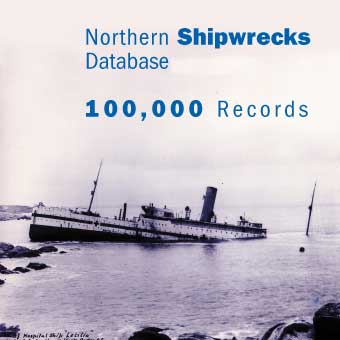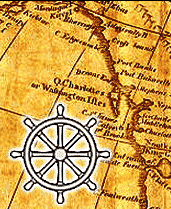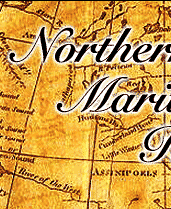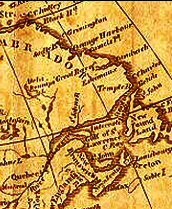There are many public sources of information for researching American shipwrecks.
This page will review and evaluate several of these sources including reports from the U.S. Navy, United States Coast Guard, United States Life-Saving Service, U.S. Government reports, Merchant Vessels of the United States, NOAA, Port of Registry - Vessel Registrations, Regional Newspapers, Registers, Directories, National and State Museums, State and Local Archives, Regional Books on Shipwrecks, Voluntary Organizations, Scuba Diving Shops and Local Boat Charters, plus other sources.
1. Merchant Vessels of the United States - These annual volumes contain one of the largest collections of American shipwreck reports to be found. While the volumes were first published in 1868, the section detailing shipwrecks did not appear until 1906. Each section offers 5 to 12 or more pages of single-line shipwreck reports. While the losses relate mainly to the previous year, the section often contains updated information on reports for several years prior to publication. These reports (up to 1968) were the basis of Bruce D. Berman's 1972 book Encyclopedia of American Shipwrecks.
(info. included on Northern Shipwrecks Database CD)
2. NOAA's Automated Wrecks and Obstructions Information System (AWOIS) - The Hydrographic Surveys Division of the National Ocean Service within the National Oceanic and Atmospheric Administration maintains the AWOIS list containing approximately 10,000 submerged wrecks and obstructions in the coastal waters of the United States. The basic information from this source includes name or description, chart number, latitude and longitude, and year recorded.
(most info. included on Northern Shipwrecks Database CD)
3. United States Navy's Non-Submarine Contact List (NSC) - A little harder to locate, this list was designed to support Naval Intelligence in that all bottom contacts would be documented so that in the event of a war, previously known contacts could be distinguished from a possible enemy submarine lying on the ocean floor. Declassified versions of this list have been in public hands for several years.
(most info. included on Northern Shipwrecks Database CD)
4. War Losses - There are many sources of vessels lost in war. Lloyd's War Losses: Second World War, 3 September 1939 - 14 August 1945 details losses from most allied countries.
(info. included on Northern Shipwrecks Database CD)
Those detailing only U.S. losses include U.S. Merchant Vessel War Casualties of World War II by Robert M Browning Jr., and Warship Losses of World War Two by David Brown, both published by the Naval Institute Press. Another excellent source from the Naval Institute Press for WW II fleets and losses from all nations is The World's Merchant Fleets - 1939 by Roger Jordan which details the fate of 6,000 ships.
(info. included on Northern Shipwrecks Database CD)
For Civil War losses, some excellent titles include Shipwrecks of the Civil War by Donald G. Shomette (1973), Beneath the Waters - A Guide to Civil War Shipwrecks by James E. Hemphill (1998), Ships Versus Shore - Civil War Engagements Along the Southern Shores and Rivers by Dave Page (1994), andTreasures of the Confederate Coast by E. Lee Spence (1996) .
(info. included on Northern Shipwrecks Database CD) 5. Directories - This includes research published by individuals or organizations. On of the best is Merchant Steam Vessels of the United States, 1807 - 1868 by William D. Lytle and edited by Forrest R. Holdcamper, and published in 1952 by the Steamship Historical Society of America, Mystic, Connecticut. While the main section details all United States merchant vessels during these years, the rear section lists the losses.
(info. included on Northern Shipwrecks Database CD)
Another excellent source of shipwreck information is the Dictionary of Disasters at Sea During the Age of Steam, 1824 - 1962 (including sailing ships and war losses) by Charles Hocking and published by Lloyd's Register of Shipping in 1968.
(most info. included on Northern Shipwrecks Database CD)
6. Local Books on Shipwrecks - Most regions have writers that specialize in shipwrecks. For the East Coast, William P. Quinn has written several books featuring excellent photographs. These include Shipwrecks Around Cape Cod (1973), Shipwrecks Around New England (1978), Shipwrecks Around Maine (1983), Shipwrecks Along the Atlantic Coast (1988), Shipwrecks in New York Waters (1989 with Paul C. Morris), Cape Cod Maritime Disasters (1990), and Shipwrecks Around Boston (1996).
(most info. included on Northern Shipwrecks Database CD)
Another prolific writer was Edward Rowe Snow (1902 - 1982) who wrote many titles detailing losses in the New England area. Some titles include: The Islands of Boston Harbor (1935), Sailing Down Boston Bay (1941), Great Storms and Famous Shipwrecks of the New England Coast (1943), Pirates and Buccaneers of the Atlantic Coast (1944),The Romance of Boston Bay (1944), Famous Lighthouses of New England (1945), A Pilgrims Return to Cape Cod (1946), Mysteries & Adventures along the Atlantic Coast (1948), Secrets of the North Atlantic Islands (1950), True Tales of Pirates and Their Gold (1951), True Tales of Buried Treasure (1953), Famous Lighthouses of America (1955), The Vengeful Sea (1956), Legends of the New England Coast (1957), Great Sea Rescues and Tales of Survival (1958), Piracy, Mutiny and Murder (1959), Women Of The Sea (1962), True Tales of Terrible Shipwrecks (1963), True Tales and Curious Legends (1969), Great Atlantic Adventures (1970), Lighthouses of New England 1716-1973 (1973), The Romance of Casco Bay (1975), Adventures, Blizzards, and Coastal Calamities (1978), Pirates, Shipwrecks and Historic Chronicles (1981), and Disaster at Sea (1990) (compilation of 3 volumes), etc.
(most info. included on Northern Shipwrecks Database CD)
For early shipwrecks around Florida, Robert F. Marx is the leader with several titles including Shipwrecks in the Americas (1971).
(most info. included on Northern Shipwrecks Database CD)
| |
On the Pacific Coast, writers such as James A. Gibbs wrote many titles detailing losses on the Pacific coast including Pacific Graveyard (1950), Tillamook Light (1953), Sentinels of the North Pacific (1955), Shipwrecks of the Pacific Coast (1957), Shipwrecks off Juan de Fuca (1962), West Coast Windjammers (1968), Pacific Square-Riggers (1969), Disaster Log of Ships (1971), Shipwrecks in Paradise (1977), Oregon's Salty Coast (1978), Peril at Sea (1986), Lighthouses on the Pacific (1986), Windjammers of the Pacific Rim (1987), etc.
(most info. included on Northern Shipwrecks Database CD)
Another West Coast writer Don Marshall wrote California Shipwrecks (1978) and Oregon Shipwrecks (1984).
(info. included on Northern Shipwrecks Database CD)
For Alaska, Shipwrecks of the Alaskan Shelf and Shore (1992) by U.S. Department of the Interior is an academic inventory of more than 1,000 Alaskan shipwrecks.
(info. included on Northern Shipwrecks Database CD)
7. Port of Registry - Vessel Registrations - This rarely used source offers a wealth of information for researchers interested in particular regions or vessels. For a vessel owner to receive official documentation on a newly-built or purchased vessel, they would present a list of the owners plus a certification of seaworthiness (vessel survey) at a Port of Registry office... normally at the first major port entered after launch or purchase. The Port of Registry office would record the vessel details, dimensions, builder(s) and the owners, etc. As the 64 shares in the vessel changed hands, the vessel registration would indicate the changes.
From these documents, two volumes published by the National Archives are List of American-Flag Merchant Vessels That Received Certificate of Enrollment or Registry at the Port of New York, 1789 - 1867. This publication covers information for one of the many ports of registry.
Active volumes of Registry are held in the local offices until the last vessel registration was closed, at which time the registration book was sent to the National Archives. As some ports registered more than 300 vessels per year while also documenting the many changes in owners (from 1 to all 64 shares), there can be many volumes for each port. A major disadvantage of this source is that while the initial registration appears on one reel of microfilm, after the page was filled with updates, any change in ownership or vessel alteration, subsequent details may appear on a another reel, with more changes being located on a third, fourth or even fifth reel. Some patience may be required to locate the information sought.
8. Newspapers - One of the original newspapers to regularly provided reports of shipwrecks was Lloyd's List. Some libraries and archives may have a rare set of the 1969 Gregg Publishing reprints of Lloyd's List in 43 bound volumes including surviving issues from 1741 to 1826. As well, regional newspapers, an excellent source of shipwreck information, can often be found on microfilm in larger libraries. Ideal for researching individual shipwrecks or events such as a famous hurricane or storm, etc.
9. Registers - All vessels are required to be registered. Most smaller vessels appear only in local Port of Registry registers (see above). Larger vessels registered with Lloyd's Register (England) , American Bureau of Shipping - (US), Bureau Veritas (France). Registers are often divided into sections for sail, steam and motor vessels. The registers provide basic information of vessels, builders and owners.
10.National, State and Local Museums - Museums can be found in both large and small communities. Some the best known include the National Maritime Museum (San Francisco, CA), Mariners Museum (Newport News, VA), Peabody Museum of Salem (Salem, MA), Mystic Seaport Museum (Mystic, CT), Chesapeake Bay Maritime Museum (St. Michaels, MD), Independence Seaport Museum (Philadelphia, PA), and Marine Museum (Fall River, MA).
11. National, State and Local Archives - Washington, DC. boasts the National Archives and Records Administration, the Library of Congress, the Smithsonian Institution - Museum of American History, and the Naval Historical Center, to name a few. For smaller archives, perform a Google search using words "Archive" or "Archives" plus the state name.
12. Voluntary Organizations - Voluntary organizations come from many backgrounds. Provincial and regional diving organizations support the diving communities with a lot of `hands-on' information of shipwrecks. Archaeological and nautical archaeology groups can prove to be a treasure chest of shipwreck information and possibly some unique diving opportunities.
13. Scuba Diving Shops and Local Boat Charters - In addition to the regional diving organizations, many local dive clubs and shops publish regular newsletters featuring shipwreck information. Most dive boat charters are very familiar with local shipwrecks. Click for details on the Northern Shipwrecks Database CD or click on CD image
© 2025 Northern Maritime Research |








